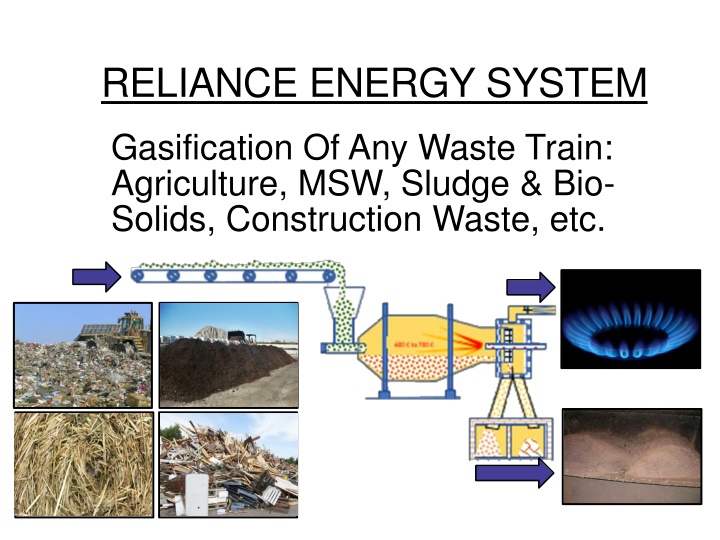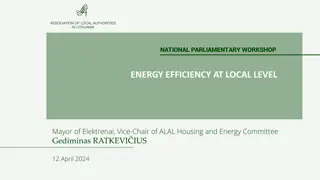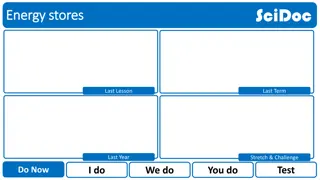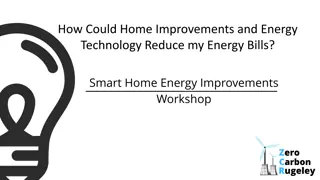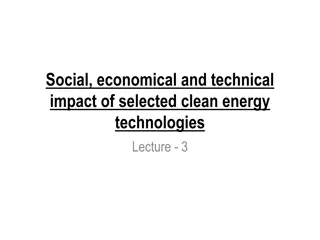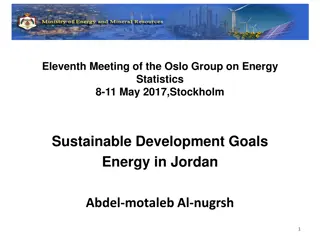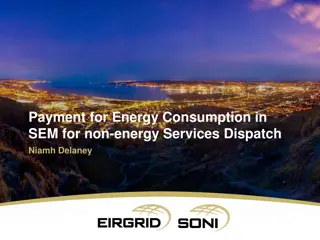RELIANCE ENERGY SYSTEM
RELIANCE.ENERGY.SYSTEM emphasizes gasification of various waste types such as agriculture, MSW, sludge, and construction waste. The content covers background, process fundamentals, commercial status, energy balances, and gasification history and types.
Download Presentation

Please find below an Image/Link to download the presentation.
The content on the website is provided AS IS for your information and personal use only. It may not be sold, licensed, or shared on other websites without obtaining consent from the author.If you encounter any issues during the download, it is possible that the publisher has removed the file from their server.
You are allowed to download the files provided on this website for personal or commercial use, subject to the condition that they are used lawfully. All files are the property of their respective owners.
The content on the website is provided AS IS for your information and personal use only. It may not be sold, licensed, or shared on other websites without obtaining consent from the author.
E N D
Presentation Transcript
RELIANCE ENERGY SYSTEM Gasification Of Any Waste Train: Agriculture, MSW, Sludge & Bio- Solids, Construction Waste, etc.
Agenda Background Process Fundamentals Commercial Status Energy Balances Gasification Relative to Today s Issues Summary 2
Background History of Gasification Charcoal formation (pyrolysis) Several thousand years old Gasification Large scale use on coal in the 1800 s; wood in 1900 s New focus alternative feedstocks 3 EPA, U.S. (2012). Technology Assessment Report: Aqueous Sludge Gasification Technologies.
Process Fundamentals General Steps 1. Drying 2. Combustion (oxidation) 3. Gasification (reduction) Main Types of Gasifiers Fixed bed Rotating Fluidized bed Tars H2 CH4 Heat Carbon Feedstock Char Pyrolysis Reactions 4
Reaction Pathways Combustion (Oxidation) Reactions Gasification (Reduction) Reactions 5
Feedstock Heating Methods Combustion: Char + Limited O2 CO2+ CO + H2O +Heat Heater Source: FEEDSTOCK W/MOISTURE>20% Plasma Torch (Westinghouse) FEEDSTOCK W/ DESIRED MOISTURE CONTENT 6
Feedstock Properties Proximate Analysis of Various Waste Train Feedstocks MSW Bio-Solids Parameter Agriculture Waste Construction Waste Ash, % 40-50 Volatile, % 40-50 Fixed C, % 5-10 HHV, Btu/lb 3000-5500 Sources: 1. Stamford Waste to Energy Draft Report; 2. Gikas et al., 2 011 9
Syngas Properties Energy Content of Syngas, Biogas and Natural Gas 100-130 Btu/ft3 typical (air-blown) Biogas ~550 Btu/ft3 Natural gas ~950 Btu/ft3 Primarily CO and H2 Usually highly diluted with N2 Syngas conditioning required for use in a gas engine Thermal oxidation of syngas avoids gas cleaning Example Syngas Composition (v/v) Hydrogen = 9% Carbon monoxide = 14% Carbon dioxide = 20% Methane = 7% Nitrogen = 50% 10
Gasification vs. Incineration Gasification Incineration Drying required as pretreatment step Designed to maximize feedstock conversion to CO and H2 Drying not required as pretreatment step Designed to maximize feedstock conversion to CO2 and H20 Highly oxidizing environment Excess air Reducing environment Limited oxygen 9
Biosolids Gasification Configurations Close-Coupled Gasification No syngas cleaning Syngas thermally oxidized Heat recovery and/or power generation from flue gas Excess Energy Wet Sludge Main Energy Sink Syngas Utilization Dewatering Drying Gasification Energy for Drying 10
Limited O2 AND /Or External Heat CLOSE COUPLED GASIFICATION Dried Sludge Excess O2 Process Heat Syngas Thermal Oxidation Flue Gas Treatment Gasification Stack Metal Granules Coated with Silica 11
Staffing Requirements Sanford facility staffing requirements 6 full-time operators Plant manager and administrator Owned and operated by MaxWest Now offering gasification equipment as capital sale Typical installed cost in the range of $7-10M 20
Syngas from Fresh Solids Rotary Fabric Fine Screen Trials with solids from Adelanto, CA WWTP January and June of 2010 Syngas properties CO = 31.5% H2= 49.2% CH4= 7.73% CO2= 3.20% 8.83% unidentified gases UHT Gasifier Gikas et al., 2011 14
Stamford, CT Waste to Energy Project High electricity costs $0.18/kwh City identified need for up to 15 MW additional power Proposed gasification system to generate electricity 25 tpd (dry) facility Produce 1-3 MW of electricity from syngas 2007 - Thermal drying facility constructed Pilot gasification facility Trailer mounted fixed-bed updraft gasifier (0.53 tpd) 2008 to 2009 - Full-scale trials with three vendors Primenergy, Nexterra, Kopf 15
Stamford Pilot Gasifier Fixed-bed Updraft Reactor Gasification pilot donated to UCONN for research in March 2012 Trailer Mounted Gasification Pilot 24 www.stamfordbiogas.com/Kappe%20Gasification%20for%20SF.pdfSimilar
Stamford/Nexterra Current Status The public balked at the project's $40 million price tag, and the WPCA board voted to kill the venture in early 2010 after losing faith in its technical and economic feasibility. Read more: http://www.stamfordadvocate.com/news/article/ Waste-to-energy-remnant-donated-to- UConn-3431002.php#ixzz2AAK4RDIv 25
Energy Balance Considerations Net Energy = Energy Outputs Energy Inputs Main energy outputs Electric power Heat Main energy inputs (parasitic loads) Dryer Blowers Gasifier startup Gasifier external energy needs Induction heater, plasma torch, etc. Syngas cleanup Courtesy of Huber 26
Power Generation Options Fuel cells not currently used with syngas Gas turbines require minimum heating value of 450 Btu/ft3 and pressurization of syngas Internal combustion engines possible Requires minimum heating value of ~140 Btu/ft3 Still may need to blend with natural gas Blended Gas Syngas Electric Power Gas Engine Engine Exhaust Heat Recovery Natural Gas (if needed) Engine Cooling Jacket Heat Recovery 27
Energy Required for Drying Thermodynamics Typically 1,400-1,700 Btu/lb of water evaporated Heat sources: Natural gas, methane, propane, electric power Recovered heat, waste heat Solar 25 dtpd gasification + thermal oxidation system could yield approx. 8-10 MMBtu/hr For a 25 dtpd drying facility: Energy Required (MMBtu/hr) 17 .4 12.2 9.0 Natural Gas Cost ($/yr) Power Cost ($/yr) Scenario 15% Solids Feed 20% Solids Feed 25% Solids Feed $1,181,000 $827,000 $614,000 $2,006,000 $1,404,000 $1,043,000 Assumes 1,500 Btu/lb water evaporated, 90% dry solids product, natural gas = 1,030 Btu/cf, natural gas =$8/1000-cf, power = $0.045/kWh 28
Energy Balances Presented in Literature 5 tpd two-stage gasification system (~4-6 mgd WWTP) Energy balances NOT from actual full-scale operation Air-Blown Gasifier1 Net output = 165 kW Assumptions: Syngas HHV = 190 Btu/ft3 System parasitic load = 75 kW Biosolids dried to 90% solids M2R/Pyromex Gasifier2 Net output = 295 kW Assumptions: Syngas HHV = 338 Btu/ft3 System parasitic load = 116 kW Biosolids dried to 78% solids M2R also presented energy balances in recent paper for a hypothetical 20 mgd WWTP (Noll, 2012) Claimed net electrical energy output of nearly 2:1 vs. anaerobic digestion 1. Source: US EPA, 2012; 2. Source: M2R Thermal Energy Conversion Brochure 2
Energy Balances Presented in Literature From Stamford Waste to Energy project report: Biosolids feed rate = 3,695 lb/hr Syngas production rate = 2,595 scfm Syngas LHV = 117 Btu/scf Quantity of syngas = 84,287 scf/ton-biosolids Cold gas efficiency = 69.4% Gross electric power production = 1,869 kW Net electric power production = 1,623 kW Proposed facility footprint of 140 x100 Project killed due to cost and technical feasibility 3
Energy Balances from Operating Facilities Kopf Balingen plant Digested sludge Equivalent to approx. 7.2 mgd Original plant used solar drying Produced ~70 kW of electric power 15 kW needed for parasitic loads ~55 kW net Produced ~140 kW of thermal energy Used to heat digesters at the WWTP Rebuilt in 2006 added belt dryer Most of the gas now used for heating the belt dryer Courtesy of Kopf 31
Energy Balances from Operating Facilities MaxWest facility in Sanford, FL Main goal is an energy-neutral system Current input to dryer is 16% solids Needs to be dried to 90% solids Current system requires natural gas supplement for dryer According to MaxWest, achieving energy-neutral requires: 23-25% solids feed depending on ratio of primary/secondary sludge 24
Economics of Two-Stage Sludge Gasification Economics largely dependent on electricity cost Renewable energy tariff New England Average Industrial Electricity Rate + RE Tariff ($0.0435/kWh) $0.093 National Average Wholesale Electricity Rate Case Electricity Cost, $/kWh $0.042 Tipping Fee, $/DT $70 $70 Annual Operating Revenue, $ $41,624 $61,7 42 Annual Operating Cost, $ ($36,995) ($41,551) Capital Costs, $ ($269,815) ($269,815) CAPEX per kW, $/kW $4,652 $4,652 Payback Years 21 7 Costs presented in USD per dry ton per day operating capacity; source: US EPA, 2012 25
Air Emissions Regulatory Requirements Currently no specific EPA regulations Case by case basis May be classified as incinerators Criteria air pollutants Sulfur oxides (SOx) Carbon monoxide (CO) Nitrogen oxides (NOx) Particulate Matter (PM) Hazardous air pollutants Hydrogen chloride (HCl) Dioxins and furans (chlorinated organics) 26
Air Emissions Data Emission Limits in 40 CFR Part 60 Final Rule for SSIs Pollutant Units Existing FB SSIs New FB SSIs MaxWest Gen #1 1 MaxWest Gen #2 2 Cadmium (Cd) Carbon Monoxide (CO) Hydrogen Chloride (HCl) Mercury (Hg) Oxides of Nitrogen (NOx) Lead (Pb) Dioxins/Furans Particulate Matter (PM) Sulfur Dioxide (SO2) mg/dscm ppmvd ppmvd mg/dscm ppmvd mg/dscm ng/dscm mg/dscm ppmvd 0.0016 64 0.51 0.037 150 0.007 4 0.10 18 15 0.0011 27 0.24 0.0010 30 0.00062 0.0044 9.6 5.3 0.0000723 7 .87 1.8 0.00798 432.17 0.000819 0.0285 9.6 4.17 - 16.1 0.321 - 15.4 - - 8.23 0.0 1. Source: US EPA, 2012 2. Source: data provided by MaxWest 27
Gasification Relative to Todays Issues Regrowth/Reactivation + Pathogens destroyed + No biosolids to dispose of Energy ? Potential for energy generation (depends on syngas quality) Resource Recovery + POTENTIAL P recovery from ash -No N recovery - Drying required as a pretreatment step - Heat recovery mostly used for drying Process Reliability -Four full-scale installations worldwide -One full-scale installation in North America Emissions + Reduced relative to incineration + Lower air requirements 28
Be Aware of the Process Cycle History Third Generation, Mature Technology Anaerobic Digestion Development / No. Installed Incineration Second Generation Biosolids Drying First Demo Thermal Hydrolysis Biosolids Gasification SCWO Time First Pilot First Applications 29
Questions? Courtesy of Nexterra Thank You! Courtesy of Kopf 38
References 1. Judex, J., Gaiffi, M., Burgbacher, H. (2012). Gasification of dried sewage sludge: Status of the demonstration and the pilot plant. Waste Management, 32 (4), 719-723. Gikas, P., Noll, S., Stedman, K. Gasification of Primary Fine-Screened Solids for Energy Production, Eurasia Waste Management Symposium, Halic Congress Center, Istanbul, Turkey, November 14-16, 2011. Mountouris, A., Voutsas, E., Tassios, D. (2008). Plasma gasification of sewage sludge: Process development and energy optimization. Energy Conversion and Management , 49 (8), 2264-2271. EPA, U.S. (2012). Technology Assessment Report: Aqueous Sludge Gasification Technologies. U.S. Environmental Protection Agency. Noll, S. (2012). A Net Energy Comparison of Anaerobic Digestion vs. Ultra-High Temperature Gasification to Achieve Zero Energy, WEF Residuals and Biosolids 2012. Li-ping, X., Tao, L., Jian-dong, G., Xue-ning, F., Xia, W., Yuan-guang, J. (2010). Effect of moisture content in sewage sludge on air gasification. J Fuel Chem Technol , 38 (5), 615-620. 2. 3. 4. 5. 6. 39
